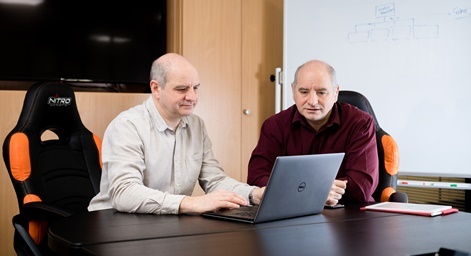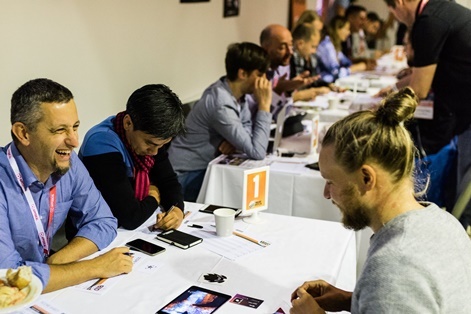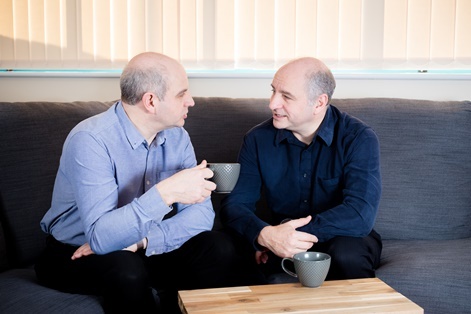In this series, Game Dragons consultant Philip Oliver addresses the serious issue of how to take your indie games development studio to the next level. This is part two, you can read part one here.
In my last article I discussed why you might need financing and where to find it. If this resulted in you wanting to seek finance from publishers or investors, then you need to make a compelling pitch.
Pitch perfect materials
When you finally get to pitch to a potential investor or publisher, you’ll get one shot and you need to make it the best pitch possible in a short space of time – often just 15 minutes.
An experienced audience will have a pretty good idea if they are interested within five minutes or less so you’ll need to sell the big vision quickly.
Make it fast, powerful, interesting and exciting. Remember that you’re not telling them “how” at this point, you’re communicating the vision with the best materials you have.
But what materials do you need?
If possible, a video on a good screen size is a must. And always have the video stored locally - never rely on having to link out to YouTube.
I’m not a fan of demos. You lose time with the equipment and then it’s slow to go through showing the potential of the game from just a few minor pieces.
Also, all too often bugs occur and can scupper your plan. It’s often better to produce a short, tightly edited video that shows the concept and scope of the game. If the client is interested, you can show more later, it’s a great ‘buy’ sign and they will give you more time to present it properly.

Next, you need to communicate supporting information. I’d use a PowerPoint or an extremely well-presented document for this. On one occasion we pitched using eight A3 double sided photo pages, bound between two etched aluminium plates which made it unique, professional and memorable!
The better the artwork and presentation the more likely the client will want to understand the details. Minimise text and communicate through pictures, diagrams and bullet points, and make sure everything is directly relevant to this project. Include a brief introduction of your team to show your skill and experience at the start too.
It’s often better to produce a short, tightly edited video that shows the concept and scope of the game. If the client is interested, you can show more later.
Often you need to introduce options (such as possible additional features, platforms or schedules) but ensure you’ve started by explaining the content of the base game first, including its schedule and rough cost.
Explain who the audience will be and outline your financial forecasts: volume of sales and pricing structure. Make it clear these are projections, reference your market data points and the success of similar games to support the figures presented. Highlight competitors and how and why you think there’s still room for your game to find a big audience. Calculate return on investment and display this prominently too.
Finally, always finish with your contact details. It needs to be as easy as possible for investors to contact you. Ensure that all materials are clearly labelled with the name of the game, your company name and logo and the date (to differentiate the latest version if updates are called for), so you can leave everything with the people you’re meeting.
The numbers
You only need ballpark figures for the first meeting. I tend to only refer roughly to the team size and time required, in months. Be ready to give a cost range, with rounded figures, in Sterling, Euros and US Dollars.
Detailed negotiations don’t tend to take place in the first meeting, so I’ll cover this in the next article.
Have the right people pitch
You might be a genius coder, but just how charismatic are you? First impressions count. You need to be friendly, confident, creative and passionate; and equally you need to be professional, to know your audience and understand their needs.
In our early days, we learnt that we were not so good at the business side and as teenagers we often didn’t get the best deals. So when we set up a development studio in the early ‘90s, even though we were already experienced, best-selling developers, we engaged an agent (Jacqui Lyons) to make introductions and do the business side of our pitches.

When it came to the creative, we’d step in and passionately run through the vision, the concepts, and detail how we could achieve what we were promising. We’d often run a demo too, after the video obviously!
The partnership worked really well and Jacqui represented Blitz for many years until we felt we had the confidence and skills required to do the business side of the pitch ourselves.
Two or three people is best, one for creative, one for business and if required, another for technical questions. Having clear roles puts the client at ease and ensures everyone knows what they need to do.
Never argue or talk over each other in a pitch and let the person who has been delegated for each role talk about their specific area.
Never argue or talk over each other in a pitch and let the person who has been delegated for each role talk about their specific area. And (it goes without saying) be well-rehearsed and prepared.
You’ll know you’re ready when you’re excited at the prospect of showing it off to clients. Confidence comes from preparation.
Make it interactive
Make brief introductions at the start of the meeting, ask them what they’re looking for and check what time they have available. Be prepared for anything from 10 to 30 minutes.
After showing the initial overview, which should only take a couple of minutes, ask them what they think. Assuming they want to know more, you’ll hopefully have another 10 to 15 minutes to take them through the rest of your materials.
Give them the opportunity to speak and give their reaction and opinion. Be open and listen to whatever they say. They are experts, and whilst you may not agree, it’s useful information. It’s only through understanding their concerns that you can address them, and either close the gap or improve your next pitch.
Take notes during the meeting, so that you can improve your presentation from one meeting to the next. It’s also worth designating one of you to mostly observing – watching the reactions of everyone else in the room can be really valuable when you debrief later.
Remember success comes from a shared vision.
Who to meet and where to meet them
Research relevant companies and contact them directly, and also make the most of trade shows. Events like Casual Connect or the London Games Finance Market are great at matching you to the exact people you need to speak to in each company. It’s important to pitch to the right person, as well as the right company. LinkedIn is also a good place to look.

Find companies that currently publish games similar to yours, or who are on an active project acquisition drive, but build relationships with potential investment or publishing partners too, so that you’re in their minds when they’re looking for someone to work with in future.
Wrapping up
Clients can’t and don't make an instant ‘yes’ decision, but make sure you have a good idea if this will go anywhere. If you’re not sure, ask them outright, “is this something you might be interested in?”.
Leave on good terms – even if they didn't like this pitch, you need to ensure they will look forward to meeting you in the future and reviewing your next pitch.
Failure should be expected
Most pitches fail. Don’t take it personally and don't pin all your hopes on one pitch. Aim to make friends, get feedback and ensure the next pitch is better as a result.
Most pitches fail. Don’t take it personally and don't pin all your hopes on one pitch.
If you keep trying, you’ll hit that serendipitous moment where you pitch well to the right people at the right time. It’s a matter of luck and perseverance combined.
A successful pitch is just the first step on a long road…
Next comes the negotiation, which I’ll cover in my next article. Before then, rest assured that we didn’t always get it right...
Pitch nightmare
Back in 2002, I made the critical mistake that I thought I could cover the creative side on a new karaoke game we were pitching.
Pop Idol had just gone massive, we had an option to buy the rights and we’d rigged a microphone to a PS2 (the first time that had been done), and I went on the road to sell the concept to publishers. Back in those days that meant going to Los Angeles. No problem, I’d done that many times!
The guys had knocked me up a great demo with two tracks to choose from - Will Young’s winning song - “Anything is possible” and Kylie Minogue's “Can’t get you out of my head”.
The game demo looked great, the voice scoring worked, but it required me to get up and sing! And that’s simply not a good idea! Unsurprisingly, asking the clients if they wanted to have a go fell flat too!
Kylie’s “Can’t get you out of my head” will always haunt me, and I disagree with Will’s “Anything is possible”! In retrospect, we should probably have hired a singer to come with us. You live and learn!
Fortunately, the story has a happy ending though, eventually leading to a great working relationship with Konami who contracted us to produce the enormously successful Karaoke Revolution: American Idol and three follow-up games. So it’s always possible to salvage something from even the most awkward pitches.






















